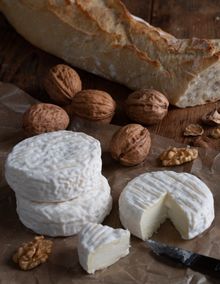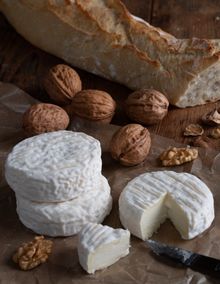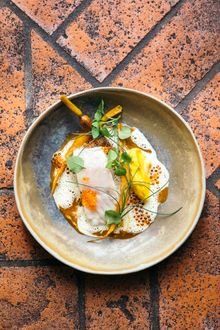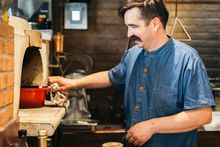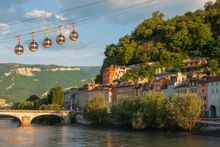 13 Oct 2025
13 Oct 2025
Autumn Highlights and Story Ideas:
The best walnuts in France
The autumn months signal the start of the walnut harvest season and the perfect time to visit Isère.
In 1938, the Grenoble walnut became the first nut in the world to receive an Appellation d'Origine Contrôlée (AOC). Today, the harvest date for the Grenoble walnut is still officially regulated by a prefectural decree, typically starting in the second half of September with the final harvest taking place at the beginning of November.
Visitors can explore the nut's history at the excellent Grand Séchoir museum in Vinay, tour a traditional walnut mill and taste regional walnut specialities including the best Tarte aux Noix in Isère Pâtisserie Laurent Champon à Vinay and Pâtisserie Petit à Saint-Marcellin, as well as excellent ravioles aux noix at La brasserie Les Agapes in Chatte.
Local Cheeses
There's no shortage of good cheeses in France but we like to think that the local Isère cheeses are some of the best.
The Bleu du Vercors-Sassenage and Saint Marcellin are the most well-known but there are dozens of others worth tasting including Brique, a brick-like goats cheese, and Tomme de Belledonne.
Try these cheeses - and others - at the source with visits to local farms and cheesemakers. La Cheverie des 7 Laux sits in the small village of Theys, in the Belledonne Massif and is run by thirty-one-year-old Laura Schmidhauser. In Villard-de-Lans, there is the award-winning Les Champs Derrière and in Oisans, the Edelweiss farm in Allemond is run by a mother-daughter team.
Visitors can find some of the best Saint Marcellin at Fromagerie Rochas in Saint-Sauveur, Fromagerie Le Murinois in Murinais and Fromagerie L'Etoile du Vercors in Saint-Just-de-Claix.
Local Wines
It's hard to believe today but in the 1850s, vine cultivation covered 33,000 hectares in Isère, the equivalent of today's Champagne vineyards. The industry was nearly wiped out in the mid-19th century owing to the devastating phylloxera epidemic but today winemaking is experiencing something of a renaissance and there are 53 winegrowers across the region who cultivate 65 hectares of vines.
Located in the Trièves region, the estate at Les P'tits Ballons is working with the association Vignes et Vignerons du Trièves to cultivate alpine grape varieties using organic methods. The estate produces original white and red wines including some that are only found in the Trièves region, such as Onchette.
In La Buisse, winemaker Sébastien Bénard has been farming organically grown vines for over a decade. He champions grape varieties from Isère and has dedicated two hectares to rare and forgotten grape varieties.
Thomas Finot moved to Bernin, on the right bank of the Isère in 2007, with the aim of restoring the reputation of the traditional Grésivaudan grape varieties. Today, his wines take pride of place on the tables of the finest restaurants.
Local Spirits
Chartreuse is undeniably the most famous of the region's liquors. The enigmatic pale green and yellow liquors have been produced by the silent order of Carthusian monks since 1737.
This winter, experience the newly revamped Museum of la Grande Chartreuse. The exhibits won't reveal what 130 botanicals are used to produce this famous drink but it will share some of the mysteries surrounding both the liquor and the silent order. In addition to a new exhibition exploring the history of the advertising Chartreuse, there's an apothecary and a cocktail bar where drinks including the legendary Last Word and the Charteuse Mule are served.
In Autrans-Méaudre-en-Vercors you will find L'Entropie, a distillery created by three friends who wanted to craft original plant based spirits and liqueurs using local plants and ingredients. Their handmade products include a floral vodka, a gin distilled with Vercors flowers and leaves and an Alpine liquor. Visit L'Entropie and see the trio at work and enjoy a tour and tasting.
Located in the heart of the French Alps, between the cliffs of the Vercors and the peaks of the Ecrins, is the oldest organic whisky distillery in the world. What was once a farm is today the Domaine des Haute Glaces, a malting house and distillery that produces exceptional spirits and local whiskies.
In September 1846, two shepherd children were reportedly visited by the Virgin Mary, receiving a message of “reconciliation” that she told them to share with the world. Today, the house where Maxim Giraud, one of the young children who saw the apparition, is the site of the La Salettina distillery. Whether or not it produces holy water remains to be seen but it does produce the very tasty IGP Génépi des Alpes liqueur, that is macerated for at least 3 years and distilled using equipment that has been in use for over a century.
Star-studded restaurants
In 2025, Isère was awarded two more Michelin stars to bring the total number up to seven Michelin starred restaurants.
The two newest restaurants to receive the prestigious accolade are located in the Vercors region. The first star was awarded to Palégrié in Autrans-Méaudre run by Guillaume Monjuré where absolutely everything is cooked over an open fire - from bread first thing in the morning to vegetables and fish during the meal - and almost everything is sourced locally. Palégrié has also been awarded a green Michelin star for its commitment to sustainable practices.
The second Michelin star was awarded to Astérales restaurant in Corrençon-en-Vercors. Named after an order of flowering plants, this restaurant reflects a low-key alpine style of cooking headed by Chef Ludovic Nardozza.
The other Michelin star restaurants in Isère are: Maison Aribert in Uriage (two stars), La Pyramide in Vienne (two stars), Le Fantin Latour, Grenoble, La table de Philippe, Girardon, Chonas-l'Amballan, Le P'tit Polyte, les 2 Alpes, L'Émulsion, Saint-Alban-de-Roche and Ambroisie, Saint-Didier-de-la-Tour.
-ENDS-
For more information please visit: https://www.Isère-tourism.com/winter

